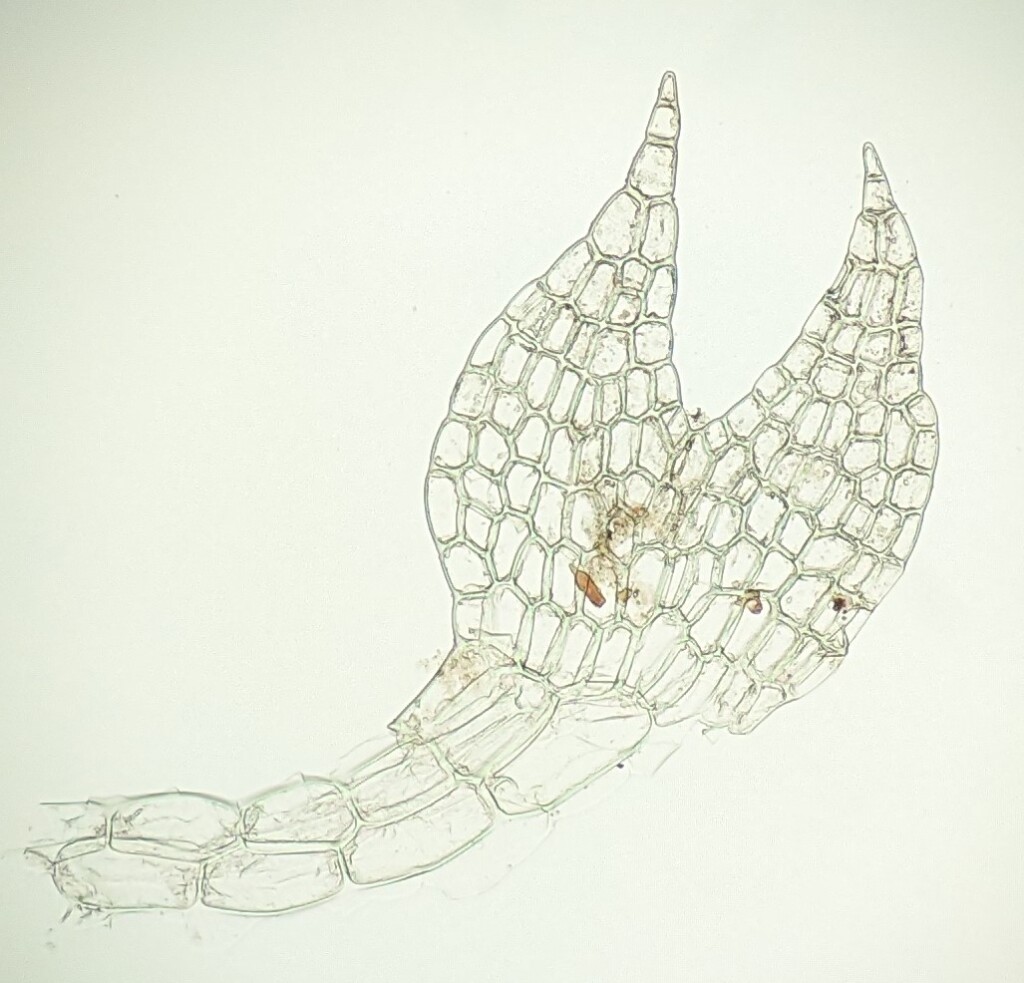Cephalozia
Terrestrial or rarely epiphytic (not in Victoria), dioicous, autoicous (not in Victoria) or paroicous (not in Victoria). Asexual reproduction rarely by single-celled gemmae at apices of erect shoot apices (not in Victoria). Stems creeping or procumbent, irregularly and sparingly branched, rarely differentiated into stems with normal leaves and those with reduced leaves (not in Victoria), with two ranks of lateral leaves or rarely with sporadic underleaves; branches emerging from main stems abaxial to unlobed or narrower lateral leaf and without a collar of tissue at base or (not in Victoria) emerging from near unmodified lateral leaves or from abaxial stem and with a collar of tissue at base. Lateral leaves orbicular or quadrate to ovate in outline, bifid or bilobed, rarely 3–4-lobed (not in Victoria), symmetric or asymmetric (not in Victoria), transverse to succubous, alternate, spreading and directed toward apex of stem, remote to imbricate, entire or (not in Victoria) crenulate to denticulate, flat (not in Victoria) to concave adaxially, unistratose; lobes triangular, acute, acuminate to filiform at apex. Underleaves mostly absent, rarely sporadically produced, ovate, unlobed, remote, entire. Leaf cells polygonal, quadrate to oblong, smooth, weakly chlorophyllose, thin- or (not in Victoria) evenly thick-walled, without trigones, without oil bodies. Rhizoids scattered, hyaline. Androecia eventually intercalary, with 3–8 pairs of leaf-like bracts, each with 1–2 antheridia. Sporophytes terminating main axes or branches (not in Victoria), developing within a perianth; perianth cylindric, trigonous toward apex, with a crenulate to ciliate or laciniate (not in Victoria) mouth; capsule ellipsoid, bistratose; elaters bispiral; spores globose, verrucose to tuberculate-vermiculate.
Twenty-seven species, shared between moist regions of the world except southern and central Africa (Söderström et al. 2016); one species, Cephalozia drucei (R.M.Schust.) Váňa in Victoria.
The circumscription of Cephalozia has changed recently so that it encompasses all of a genetic lineage recovered in phylogenetic analyses of nuclear and chloroplast DNA sequences (Vilnet et al. 2012; Feldberg et al. 2016). This has required Metahygrobiella R.M.Schust. to be subsumed into Cephalozia and either many of its species transferred to Fuscocephaloziopsis Fulford (e.g. Söderström et al. 2016; Feldberg et al. 2016) or for it to be recognised in a broader sense that includes Fuscocephaloziopsis as well as Nowellia Mitt. (Potemkin & Sofronova 2013). This treatment follows the former approach which has the benefit of maintaining Nowellia that is easily distinguished from Cephalozia by its leaves with water-sacs.
Feldberg, K., Váňa, J., Krusche, J., Kretschmann, J., Patzak, S.D.F., Pérez-Escobar, O.A., Rudolf, N.R., Seefelder, N., Schäfer-Verwimp, A., Long, D.G., Schneider, H. & Heinrichs, J. (2016). A phylogeny of Cephaloziaceae (Jungermanniopsida) based on nuclear and chloroplast DNA markers. Organisms, Diversity & Evolution http:doi10.1007/s13127-016-0284-4.
Potemkin, A.D. & Sofronova, E.V. (2013). Taxonomic study on the genus Cephalozia in Russia and circumscription of the genus. Arctoa 22: 173–206.
Söderström, L., Hagborg, A., von Konrat, M., Bartholomew-Began, S., Bell, D., Briscoe, L., Brown, E., Cargill, D.C., Costa, D.P., Crandall-Stotler, B.J., Cooper, E.D., Dauphin, G., Engel, J.J., Feldberg, K., Glenny, D., Gradstein, S.R., He, X., Heinrichs, J., Hentschel, J., Ilkiu-Borges, A.L., Katagiri, T., Konstantinova, N.A., Larraín, J., Long, D.G., Nebel, M., Pócs, T., Puche, F., Reiner-Drehwald, E., Renner, M.A.M., Sass-Gyarmati, A., Schäfer-Verwimp, A., Moragues, J.S., Stotler, R.E., Sukkharak, P., Thiers, B.M., Uribe, J., Váňa, J., Villarreal, J.C., Wigginton, M., Zhang, L. & Zhu, R. (2016). World checklist of hornworts and liverworts. Phytokeys 59: 1–828.
Vilnet, A.A., Konstantinova, N.A. & Troitsky, A.V. (2012). Molecular phylogeny and systematics of the suborder Cephaloziinae with special attention to the family Cephaloziaceae s.l. (Jungermanniales, Marchantiophyta). Arctoa 21: 113–132.
 Spinning
Spinning